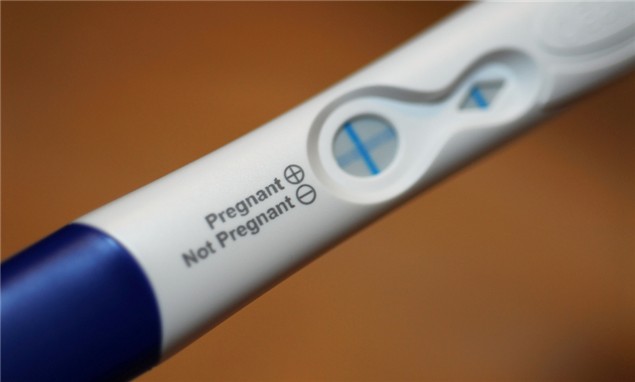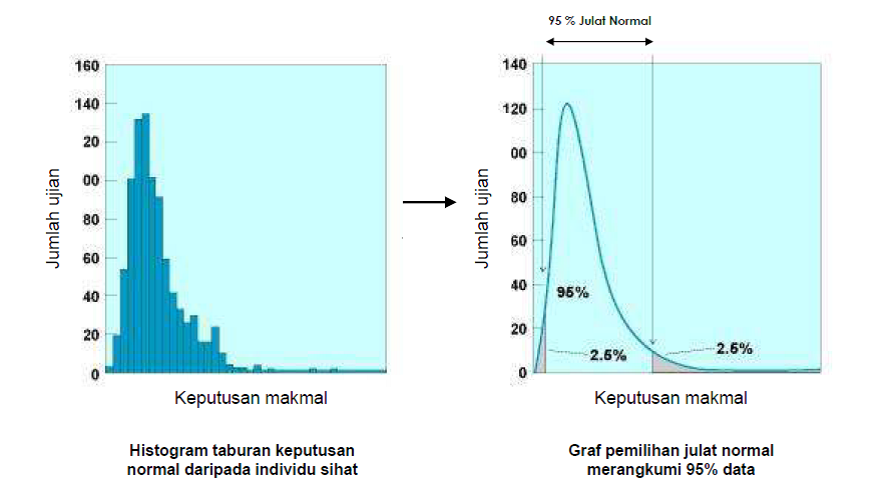Introduction
Have you been to hospital or clinic and asked by the staff to take urine or blood samples for laboratory investigations?
Laboratory testing usually is a must in Malaysia especially in medical check-up for college or university admission, pre-marital medical test and the most common for women is maternity check-up.
In reference to a laboratory test, what does ‘out of the normal range’ actually mean? Is it a cause for concern? The brief answer is that a result out of the normal range signals the need for further investigation. Interpreting any clinical laboratory test involves comparing the patient’s results to the normal values. Normal values also commonly called the reference range, normal range or reference interval.
 |
Urine pregnancy test is one of the simplest laboratory tests. The normal value expressed in qualitative mean (positive or negative). |
Normal Value
Normal values for blood investigations are commonly used in biochemistry area (also known as chemical pathology or clinical biochemistry); one of the main areas in medical pathology focused on blood, urine and other body fluids investigation.
Physicians or medical practitioners will interpret any clinical laboratory test report generated from patient’s sample (e.g. blood, urine and other body fluids) for further investigation.
Establishing The Normal Value
Biochemical test results are usually compared to a normal value chosen arbitrarily to include 95% of healthy individual in any population. This means by definition, 5% of any population will have results outside the normal values.
The latest edition of the Clinical and Laboratory Standards Institute (CLSI) approved guideline has recommended that normal value be established by selecting a statistically sufficient group (a minimum of 120) of healthy reference subjects. In reality, there will always be some other criteria which must be fulfilled.

Normal value is include 95% of healthy individual in any population
There are some levels of uncertainty with a given protocol not only because of the definition of health that was selected but also because of the very real possibility that some of the selected subjects may, in fact have subclinical diseases.
Recruiting a valid group of reference subjects and obtaining informed consent in today’s environment is costly, time-intensive, and virtually an impossible task for most laboratories. The challenge is further magnified in establishing normal range for different age groups (e.g. pediatric patients and geriatric patients), uncommon sample types (e.g, cerebrospinal fluid), timed collections, challenge tests and serial measurements.
Verification of Normal Value
In light of these difficulties, most laboratories elect not to establish their own normal values but rather choose to verify normal values that have been reported by the manufacturer, published literatures/textbooks or as established by another laboratory.
This is a relatively simple study and requires only 20 healthy subjects to recruit. The underlying assumption here is that the laboratory analytic system is calibrated and producing similar results as the method that was originally used in the published normal values. However, all results must be tested with a valid statistical rule.
Factors Affecting Normal Value
For many tests, there is no single reference range that applies to everyone because the tests performed may be affected by the age and sex of the patient, as well as many other considerations. Consequently, there is no such thing as a standard reference range.
The discrimination between normal and abnormal results are affected by various physiological factors that must be considered during interpreting any laboratory result. These include:
-
Sex – Normal values for some analytes such as serum creatinine which is higher in male than female.
-
Age – There may be different normal values for neonates, children, adults and the elderly.
-
Diet – The sample may be different for certain test (e.g. glucose) if taken when the patient is fasting or after a meal.
-
Timing – There may be variations during the day and night (e.g. serum cortisol which peak in the morning and lowest at midnight).
-
Stress and anxiety – These may affect the analyte of interest such as glucose will higher if under stress.
-
Posture of the patient – Redistribution of fluid may affect the result.
-
Effects of exercise – Strenuous exercise can release enzymes from tissue.
-
Medical history – Infection and/or tissue injury may affect certain biochemical values.
-
Pregnancy – This alters some normal values.
-
Menstrual cycle – Hormones measurement will vary throughout the menstrual cycle.
-
Drug history – Drugs may have specific effects on some biochemical analytes.
In Summary
Remember, an abnormal or outside the normal value test result is a not always a sign of a problem. Your doctor still has to interpret the results with some other variables and does the result fit with history and clinical examination of the patient.
It is importance to realize that reference ranges are specific to the laboratory that produces the test results. For many biochemical tests, different laboratories use different kinds of equipment and different methods of testing. This means that each laboratory has its own reference range using data from its own equipment and methods.
If your doctor suspects that the result may indicate a problem, the first action is usually to rerun the test. As accurate as modern laboratory tests are under optimal testing circumstances, many factors that we cannot control (heat, humidity, transport time, etc.) can affect any given test results.
Conversely, if all your test results are normal, you are not guaranteed to be ‘bullet-proof’. If you are trying to follow a healthy lifestyle, take it as a good sign and keep it up. But if you are engaging in high-risk behavior, such as drug and alcohol abuse or a poor diet, it only means ‘so far so good’, and the potential consequences have not caught up with you yet.
A good test result is not a license for an unhealthy lifestyle. A few tests over time are more accurate than a single snapshot. If you previously had abnormal results, normal results certainly provide good news. But your doctor may want to conduct follow-up tests some months later to make sure you are still on track and also to document the trend.
References
-
Alex Katayev, Claudiu Balciza, David W. Seccombe (2010). Establishing reference intervals for clinical laboratory test results. Is there a better way? Am J Clin Pathol 2010;133:180-186.
-
Mujdat Aytekin, Kaya Emerk (2008). Accurate reference intervals are required for accurate diagnosis and monitoring of patients. eJIFCC 2008, 19 (2).
-
Vidya Mave, Vandana Kulkarni, Renu Bharadwaj, Medha Khandekar, Amita Gupta, Nikhil Gupte (2012) Determination of a reference interval in a population. Natl Med J India 2012;25:33–34.
-
Allan Gaw, Michael J. Murphy, et al (2008). Clinical Biochemistry. An Illustrated Colour Text. (4th. Edition). Churchill Livingstone Elsevier.
-
Joseph Henny (2009). The IFCC recommendations for determining reference intervals: strengths and limitations. J Lab Med 2009;33(2):45–51
| Last Reviewed | : | 3 January 2014 |
| Writer | : | Syafiq Akram b. Suhaymin |







